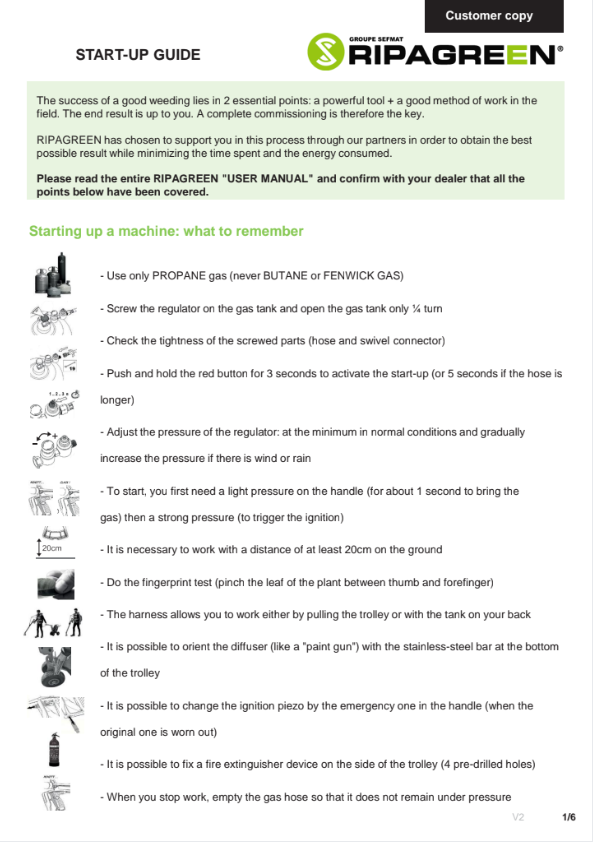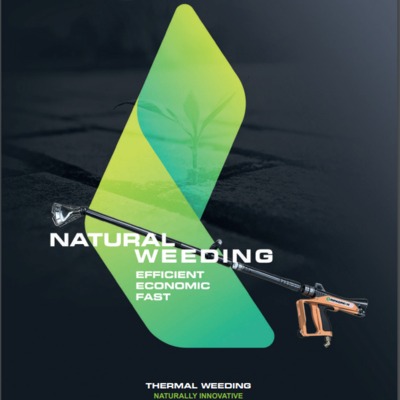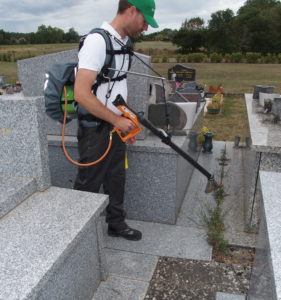Ripagreen Thermal Weed Control

Ripagreen Thermal Weed Control Overview
The new generation of professional thermic hot air blowers has been invented by RIPAGREEN®. Its process forces high velocity hot air over the leaf of a plant.
This hot air instantly causes a thermal shock that breaks the chlorophyll producing part of the plant, the process of photosynthesis is prevented. The plant then dries naturally with a visible result after a few hours.
To effectively weed with RIPAGREEN®, it is not necessary to burn the plant, but only give it a "hot shot" (about 80 ° in the thickness of the leaf). The action is immediate, bringing a saving of time and consequent energy. The "reserves" in its roots of the plant will determine how effective the treatment is. This treatment is therefore more effective on plants at seedling / young shoot stage. With a regular frequency of passage, the plant will be weakened until it is exhausted
Ripagreen Frequently Asked Questions
The Ripagreen uses hot air to kill weeds. When a plant is exposed to temperatures of more than about 76 degrees, the chloroplasts (the cells in the leaf that carry out photosynthesis) will burst or congeal. By destroying these cells, the plant is unable to convert light into energy. It therefore starves the plant, which dies within 72 hours. You will usually start to see the effects of the heat treatment within a few minutes.
The Ripagreen kits can be supplied with a back pack system, making them just as portable as a knapsack sprayer. The backpacks are more comfortable and lighter than most knapsacks at around 14kg, with support for the lance and a patented back pillow that can be pumped up for additional support.
The ripagreen uses 94% air mixed with only 6% propane gas. This makes it very efficient, so bottles have to be changed less frequently than you would need to top up with herbicide.
Because of the nature of hot air, there is no drift or risk of run off. It is effective in the wet or dry, so this makes it a much more versatile option for use in all weather conditions.
There are two typical sizes of gas bottle for the Ripagreen. The easy kit uses a 13kg bottle and the mobility kit uses a 5.5kg bottle of gas. You can get these bottles from your local calor or flogas stockists.
The ripagreen uses a regulator to adjust gas consumption. On a low setting the gas is used at approximately 2.9 KG per hour. So this will last about 2 hours of trigger time in the smaller bottle and 4 - 5 hours using the larger bottle.
The machine only uses gas when the trigger is pulled, which means that gas is not consumed when it is not pointed at a weed. In typical conditions this means that a bottle will realistically last much longer than the times stated above.
The short answer is yes. But this is subjective. The ripagreen system is extremely efficient compared to other heat systems on the market such as hot water of foam. The ripagreen uses 96% air and only 6% propane gas. Some other weed burners require a pilot flame to be lit all the time, which wastes gas. The ripagreen uses gas only on demand when the trigger is pulled.
Propane is also an efficient gas to burn, producing mainly water vapour and small amounts of Co2 as a biproduct when burned properly.
This makes it very clean compared to products that burn petrol or deisel in order to operate, and makes it safe to use in many areas where herbicides such as glyphosate are unsuitable or simply undesirable.
The heat used to kill weeds with the Ripagreen system is an energy. This limited energy is thouht to have little secondary effect on the environment. Liquid compounds used in pesticides are substances. Subtances may be capable of multiple secondary effects on the environment.
Further to this you can make this solution more environmentally friendly by following a Weed Prevention Strategy. find out more about Weed Prevention strategies here
The Ripagreen uses hot air to kill plants. This method is suitable to use in a much wider variety of weather than many other systems.
The hot air is not affected by drift in the same way chemicals are, so the Ripagreen can be used in moderately windy conditions, provided the flame can be safely controlled.
The Ripagreen is just as effective at killing the plant in the rain, as moisture is a good conductor of heat. The ripagreen operates at temperatures of between 400 - 600 degrees celsius, so it is not largely affected by cold or wet weather.
This makes is a reliable tool for year - round use.
Care should be taken on very hot and dry days, as the heat can cause very dry maerial to catch fire. It is good practice to carry a fire extinguisher when using the Ripagreen and other flame or heat based weed control products.
The gas bottles for the Ripagreen system are commonly available from local gas stokists of Calor or flogas. The gas used is Propane gas commonly used for BBQ's and other heating. We like these new Gaslight cylider from Flogas becase they are much lighter to carry than their steel equivilent. Check them out here Gaslite Cylinders by Flowgas https://www.flogas.co.uk/product/5kg-gaslight?c=all-cylinders
No you do not need a licence to use a Ripagreen Thermal Lance to kill weeds.
Manufacturers specification states the the Ripagreen machine operates at levels of less than 85db. This is an industry standard figure above which ear protection is required. In our experiance however, the Ripagreen lance operates at a level around 60-70db or equivilent to a conversation. Our tests have shown that the operation of the machine in public areas does not appear to cause any concern or behavioral change in peoples attitude.
The Health and Safety Executive (HSE) provide information on their website regarding various aspects of storage, transporting, use and disposal of LPG cylinders. The suppliers of the gas such as Calor and Flogas also provide information. Training should be provded to the opperator on installation of the equipment by either Kersten (UK) Ltd or your supplying dealer. HSE state the following : LPG cylinders Cylinders should be stored preferably in the open air on a concrete or load-bearing surface. Flammable liquids, combustible, corrosive, oxidising materials, toxic materials or compressed gas cylinders should be kept separate from LPG containers in general. Containers should be stored with their valves uppermost. The maximum size of any stack should not exceed 30,000 kg. For storage indoors, no more than 5000 kg may be stored in each purpose designed building compartment and a maximum of five compartments may exist in a single building.
Liqid Gas UK website provides a useful PDF information sheet regarding the use of LPG in cylinders. We have provided a link to this document here
The obvious risk to damage to property is fire. As the required heat to kill a plant is only around 75-85 degrees there is no requirement to concentrate heat on any surface long enough to cause ignition. It is good weed prevention practice to remove all detritus from hard surfaces. This is especially important to reduce any risk of fire. A risk assessment should be conducted on all areas and all risks minimised or mitigated. These product have been used, without incident on many types of ancient and modern surfaces.
Rough gas usage on young annual weeds is 1x 5kg bottle per 1000m² (weeds up to 100mm high)
Rough gas usage on established annual weeds is 1x 5kg bottle per 500m² (weeds up to 200mm high)
Rough gas usage on established perennial weeds is 1 x 5kg bottle per 250m² (Weeds up to 200mm high)
It is difficult to establish the gas usage for weeds outside this specification.
Consider using mechanical methods instead.
Consioder removing the cause of the plants access to soil on hard surfaces.
Use biological controls on organic surfaces such as mulching, dense planting of a desirable species, change treatment timings to fall within the above specification.
Cost of 5kg refill GASLITE cylinder from FLOGAS is about £35.00
In comparison The Easy+ kit uses a 10 - 12kg cylinder on the trolley and the lance as above. A refill for this is considerably cheaper at about £42 which roughly halves to cost of the gas.
Notes. Prior to heat weed control solutions it is recommended all sites are cleared of detritus.
The Ripagreen Thermal weed control lance remains cool during use. This is because large volumes of air are being forced through the handle, tube and nozzle before being ignited only at the very end of the lance. The head can even be adjusted immediately after use, as long as the head has been kept the correct distance from the ground. If it has been held too close to the ground, the head can potentially get hot from reflected heat.
No, the Ripagreen thermal lance must be squeezed to operate it. The gas and ignition stops immediately when the lance handle is released.
No, the plant leaf only requires a temperature of less than 80 degrees Celcius to burst the cells in the leaf which leads to the demise of the plant.




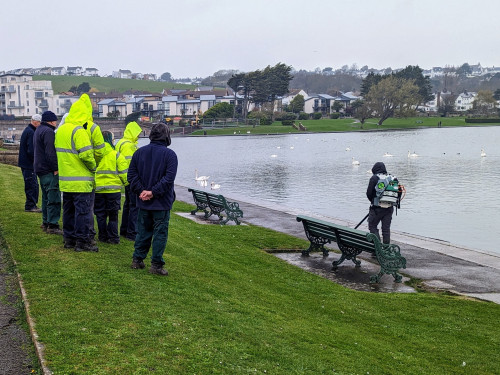




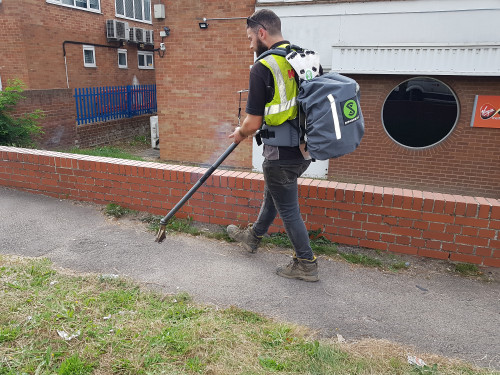


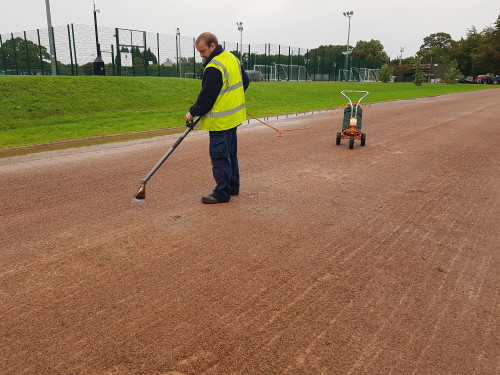
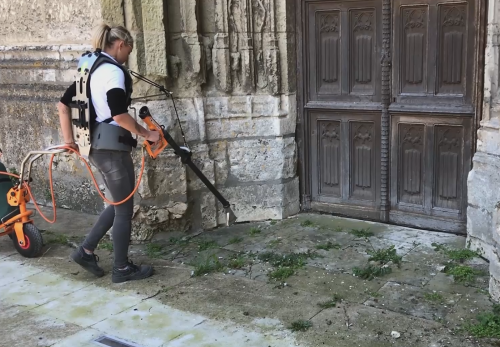

.webp)
 180dpi.webp)
.webp)



